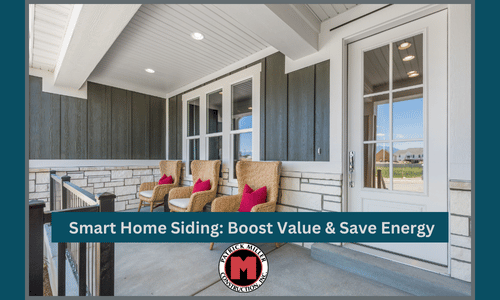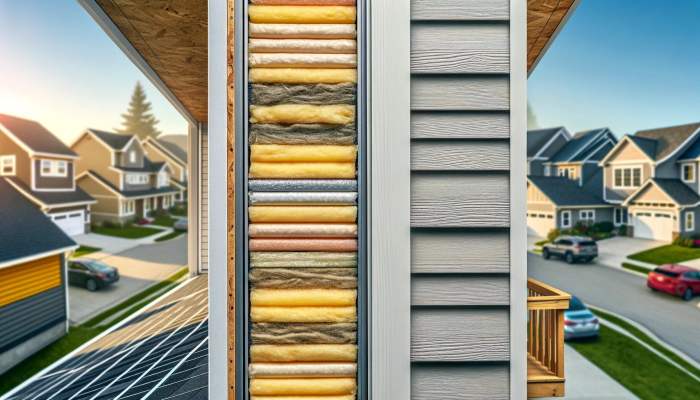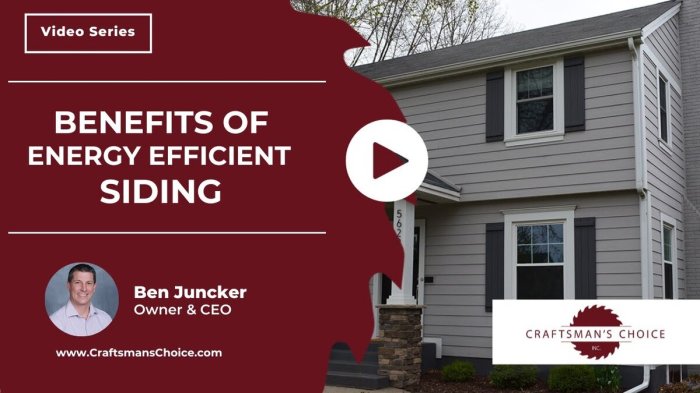
Exploring the realm of Energy-Efficient Siding: Does It Really Save Money?, this introduction sets the stage for an informative and captivating journey, drawing readers in with its engaging narrative style.
The following paragraph delves into the intricacies of the topic, providing a clear and detailed overview.
Energy-Efficient Siding Material
Energy-efficient siding is designed to improve the insulation of a building, reducing energy consumption for heating and cooling. This type of siding helps maintain a consistent indoor temperature, leading to lower energy bills and a reduced carbon footprint.
Popular Energy-Efficient Siding Materials
- Vinyl Siding: Vinyl siding is a popular choice for its energy efficiency and affordability. It offers good insulation properties and comes in a variety of colors and styles.
- Fiber Cement Siding: Fiber cement siding is known for its durability and resistance to harsh weather conditions. It provides excellent insulation and can mimic the look of wood or stucco.
- Insulated Siding: Insulated siding features a layer of foam insulation attached to the back of the siding panels. This added insulation helps improve energy efficiency and reduce heat loss.
Key Features of Energy-Efficient Siding
- Thermal Resistance: Energy-efficient siding materials have high thermal resistance, which helps prevent heat transfer between the interior and exterior of a building.
- Air Sealing: Energy-efficient siding is designed to reduce air leakage, preventing drafts and improving the overall energy efficiency of a home.
- Moisture Resistance: Energy-efficient siding materials are resistant to moisture, preventing water damage and mold growth in the walls of a building.
Cost Comparison
- While energy-efficient siding materials may have a higher upfront cost compared to traditional options, they can lead to significant savings in energy bills over time. The long-term cost-effectiveness of energy-efficient siding should be considered when making a decision.
- Factors such as material quality, installation costs, and energy savings potential should be taken into account when comparing the costs of energy-efficient siding with traditional materials.
Environmental Impact
Energy-efficient siding is not only beneficial for reducing energy costs but also has a positive impact on the environment. By improving insulation and reducing the transfer of heat in and out of a building, energy-efficient siding can significantly lower energy consumption.
Reduction in Energy Consumption
- Energy-efficient siding helps maintain a consistent indoor temperature, reducing the need for heating and cooling systems to work harder.
- Less energy consumption leads to lower greenhouse gas emissions, helping combat climate change.
Environmental Benefits
- By decreasing energy usage, energy-efficient siding contributes to a reduction in fossil fuel consumption, which is a major source of pollution.
- Improved insulation from energy-efficient siding can also lead to a decrease in overall energy demand, supporting sustainability efforts.
Statistics and Case Studies
According to the U.S. Department of Energy, energy-efficient siding can reduce heating and cooling costs by up to 20%.
A study by the Environmental Protection Agency found that energy-efficient siding can reduce carbon dioxide emissions by an average of 1,000 pounds per year for a typical home.
Cost Savings

.id/wp-content/uploads/2025/08/energy-efficient-siding-2.jpg" alt="Energy Efficient Siding: How Does James Hardie Siding Rank | Joseph ..." width="700" height="468" />
Energy-efficient siding can lead to significant cost savings over time for homeowners. By reducing energy consumption and improving insulation, this type of siding helps lower utility bills and maintenance costs in the long run.
Factors Contributing to Cost Savings
- Improved Insulation: Energy-efficient siding helps maintain indoor temperatures, reducing the need for heating and cooling systems to work overtime, thus lowering energy bills.
- Durability: High-quality energy-efficient siding materials are more durable and require less maintenance, saving homeowners money on repairs and replacements.
- Tax Incentives: Some energy-efficient siding options may qualify for tax credits or incentives, providing additional savings for homeowners.
Comparison of Long-Term Costs
- Energy-Efficient Siding: While the initial cost of energy-efficient siding may be higher than standard siding materials, the long-term savings on energy bills and maintenance expenses can outweigh the upfront investment.
- Standard Siding Materials: Traditional siding materials may be cheaper initially, but they can result in higher energy costs and more frequent repairs, leading to increased expenses over time.
Real-Life Examples
- A family in a cold climate area installed energy-efficient siding and saw a noticeable decrease in their heating bills during winter months.
- Another homeowner invested in energy-efficient siding and experienced fewer issues with moisture and mold, saving money on remediation and repairs.
Installation and Maintenance

Installing energy-efficient siding is a crucial step in maximizing its effectiveness and ensuring long-term cost savings. The process typically involves the following steps:
Installation Process
- Prepare the surface: Before installing energy-efficient siding, it is essential to properly clean and prepare the surface to ensure a secure attachment and optimal performance.
- Measure and cut the siding: Accurate measurements and precise cutting of the siding panels are crucial for a seamless and professional installation.
- Secure the siding: Use the appropriate fasteners and techniques to securely attach the siding to the exterior walls, following the manufacturer's guidelines.
- Finish and seal: Complete the installation by sealing the joints and finishing the edges to prevent moisture infiltration and maximize energy efficiency.
Special Considerations
- Weather conditions: Installation of energy-efficient siding may require specific temperature and weather conditions for optimal results, so it is essential to consider the climate when scheduling the installation.
- Professional installation: While some homeowners may choose to install siding themselves, hiring a professional contractor experienced in energy-efficient siding can ensure proper installation and long-term performance.
Maintenance Requirements
- Cleaning: Regularly clean energy-efficient siding with a mild detergent and water to remove dirt, debris, and mold that can affect its performance.
- Inspection: Periodically inspect the siding for any signs of damage, such as cracks or warping, and address any issues promptly to prevent further damage.
- Repairs: In case of damage, repairs should be done using compatible materials to maintain the energy-efficient properties of the siding.
Tips for Maintenance
- Trim vegetation: Keep plants and trees trimmed away from the siding to prevent damage and maintain proper airflow.
- Check seals: Regularly inspect the seals and caulking around windows, doors, and other openings to ensure they are intact and prevent air leakage.
- Professional inspection: Consider scheduling a professional inspection of the siding every few years to identify any potential issues early and address them proactively.
Summary

Concluding our discussion on Energy-Efficient Siding: Does It Really Save Money?, this final section encapsulates the key points discussed in a compelling and concise manner, leaving readers with food for thought.
Query Resolution
Does energy-efficient siding really save money in the long run?
Yes, energy-efficient siding can lead to significant cost savings over time due to reduced energy consumption.
What are some popular energy-efficient siding materials available in the market?
Examples include vinyl, fiber cement, and insulated siding, known for their energy-saving properties.
Are there any environmental benefits to using energy-efficient siding?
Absolutely, energy-efficient siding helps reduce energy consumption, leading to a positive environmental impact by lowering carbon emissions.
How does maintenance for energy-efficient siding differ from traditional siding?
Energy-efficient siding typically requires less maintenance compared to traditional options, resulting in long-term savings.
 Exploring the realm of Energy-Efficient Siding: Does It Really Save Money?, this introduction sets the stage for an informative and captivating journey, drawing readers in with its engaging narrative style.
The following paragraph delves into the intricacies of the topic, providing a clear and detailed overview.
Exploring the realm of Energy-Efficient Siding: Does It Really Save Money?, this introduction sets the stage for an informative and captivating journey, drawing readers in with its engaging narrative style.
The following paragraph delves into the intricacies of the topic, providing a clear and detailed overview.
 Installing energy-efficient siding is a crucial step in maximizing its effectiveness and ensuring long-term cost savings. The process typically involves the following steps:
Installing energy-efficient siding is a crucial step in maximizing its effectiveness and ensuring long-term cost savings. The process typically involves the following steps:
 Concluding our discussion on Energy-Efficient Siding: Does It Really Save Money?, this final section encapsulates the key points discussed in a compelling and concise manner, leaving readers with food for thought.
Concluding our discussion on Energy-Efficient Siding: Does It Really Save Money?, this final section encapsulates the key points discussed in a compelling and concise manner, leaving readers with food for thought.












